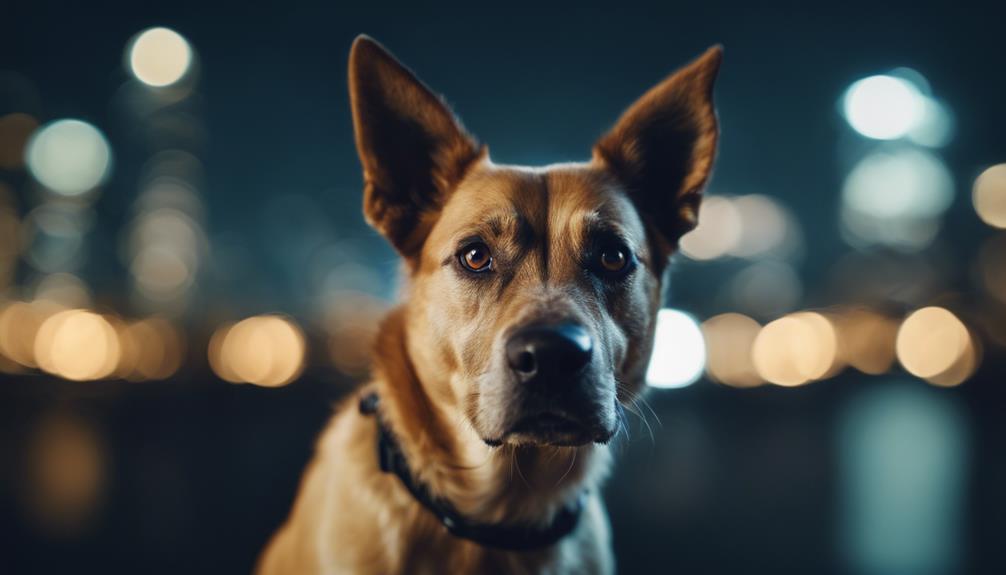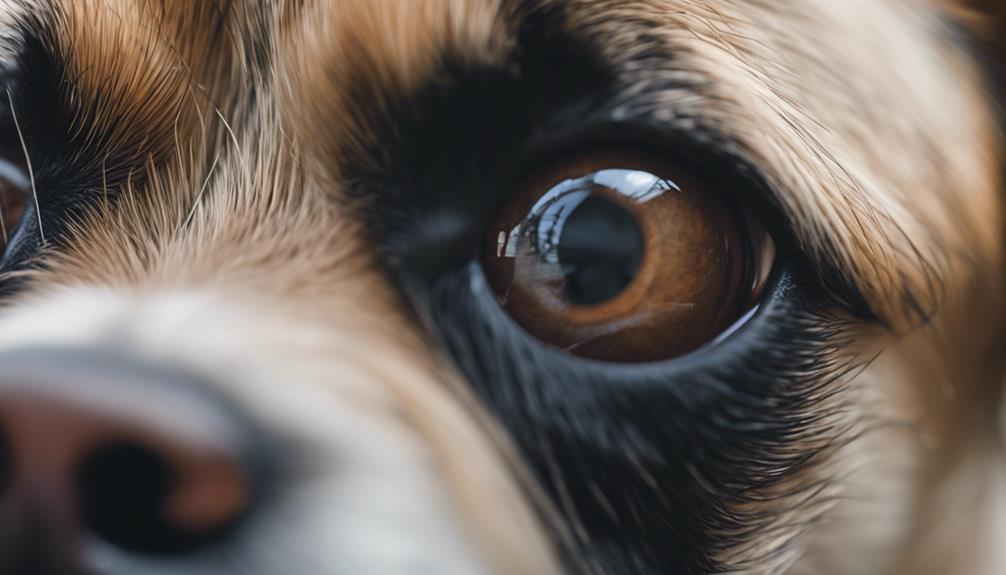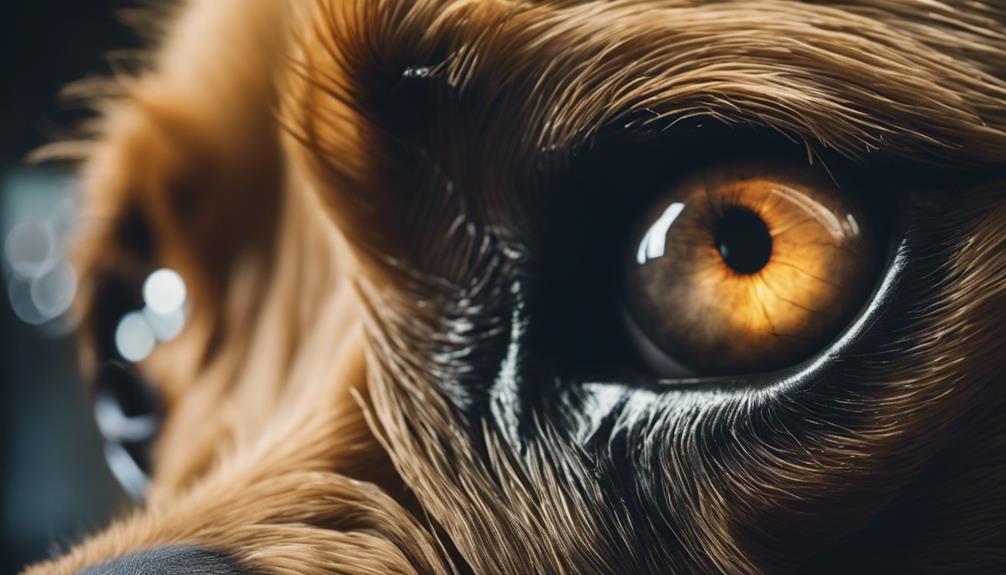Embarking on a journey to comprehend how dogs perceive the world through their eyes opens a realm of intriguing revelations.
A veterinary ophthalmologist serves as our guide, unraveling the intricacies of canine vision in a manner that sheds light on the unique visual landscape that our furry companions inhabit.
As we explore the nuances of dogs' vision capabilities, from their specialized motion detection to their exceptional night vision, a deeper appreciation for the world as seen through a dog's eyes begins to unfold.
Stay tuned as we uncover the fascinating insights that await regarding our canine friends' visual experiences.
Key Takeaways
- Dogs see the world in blue and yellow hues, lacking full color vision like humans.
- Their superior night vision stems from more rods and a tapetum lucidum.
- Dogs' vision, around 20/40 to 20/50, prioritizes motion detection over fine details.
- Aging dogs may show signs of vision decline, needing attentive care and check-ups.
Canine Vision Vs. Human Vision
When comparing canine vision to human vision, it is evident that dogs and humans perceive the world differently due to variations in their visual capabilities. Humans have a higher number of cones in their retinas, enabling them to perceive a broader spectrum of colors and finer details. In contrast, dogs have more rods, which are specialized for detecting motion and performing well in dim light conditions.
While humans enjoy sharper vision and color perception, dogs excel in detecting movement, making them well-suited for activities requiring motion detection. Understanding these differences is crucial in comprehending how dogs interact with their environment and how their unique visual abilities shape their behaviors and responses to stimuli.
Dogs' Color Perception
Dogs' perception of color is dichromatic, limiting their visual spectrum to primarily blue and yellow hues. This unique color vision impacts how dogs perceive the world around them.
Here are four key points to understand dogs' color perception:
- Limited Color Range: Dogs see the world in shades of blue and yellow, lacking the ability to distinguish between red and green hues like humans.
- Different Perception of Objects: Grass, for instance, appears differently to dogs due to their limited color vision compared to humans.
- Color Preferences: Dogs may show preferences for toys or objects in certain colors within their limited spectrum of blue and yellow.
- Adaptation in Environment: Despite their restricted color vision, dogs effectively adapt to their surroundings using other senses like smell and hearing.
Night Vision in Dogs

Having discussed the limitations of dogs' color perception, a significant aspect to explore is their exceptional ability to see in low light conditions, known as night vision. Dogs have superior night vision compared to humans due to having more rods in their eyes.
Most dog breeds possess a reflective layer called the tapetum lucidum, which enhances their night vision by reflecting light back through the retina. This allows dogs to see well with ambient lighting at night and eliminates the need for additional light sources.
However, it is essential to note that like humans, older dogs may experience a decline in their night vision over time. Understanding and appreciating dogs' night vision capabilities can help in providing them with the care and environment they need to thrive in various lighting conditions.
Nearsightedness and Farsightedness
The prevalence of nearsightedness and farsightedness in dogs varies among different breeds and can impact their visual capabilities in specific tasks. Understanding these visual impairments is crucial for ensuring dogs' well-being and performance in various activities.
- Nearsightedness:
- Certain breeds, such as Labradors, may exhibit nearsightedness.
- This condition can affect their ability to focus on objects that are far away.
- Farsightedness:
- Some dogs may experience farsightedness, making it challenging to see objects up close.
- Tasks requiring close-up precision may be more difficult for farsighted dogs.
Breeds Prone to Vision Issues

Certain breeds exhibit a higher susceptibility to vision impairments, necessitating proactive monitoring and care to maintain their visual health. Breeds such as the Bulldog, Pug, and Boxer are predisposed to eye conditions like corneal ulcers, cherry eye, and progressive retinal atrophy. Collies and Australian Shepherds are prone to collie eye anomaly, a genetic condition that can lead to blindness.
Cataracts are common in breeds like the Cocker Spaniel, Havanese, and Bichon Frise. Additionally, the Dachshund is known to have issues with glaucoma. Regular eye examinations by a veterinary ophthalmologist are crucial for early detection and management of these conditions, helping to preserve the visual acuity of dogs predisposed to vision problems.
Aging Effects on Dog Vision
As dogs age, changes in their vision can manifest, impacting their daily interactions and activities.
These aging effects on dog vision include:
- Cataracts: Older dogs are more prone to developing cataracts, leading to cloudiness in the lens and potentially causing vision impairment.
- Glaucoma: Aging can increase the risk of glaucoma in dogs, a condition characterized by increased pressure within the eye, which can be painful and damaging to vision.
- Decreased Visual Acuity: Older dogs may experience a decline in visual acuity, making it harder for them to see objects clearly, especially in low light conditions.
- Reduced Night Vision: With age, dogs may struggle more with night vision, leading to difficulties navigating in dimly lit environments.
Signs of Vision Problems

Aging effects on dog vision, particularly the development of cataracts and glaucoma, can often be accompanied by noticeable signs indicating potential vision problems in senior dogs. As dogs age, their vision tends to deteriorate, leading to difficulties in dim lighting and navigation.
Senior dogs with vision issues may display hesitancy when moving around, have trouble navigating stairs, or exhibit behavioral changes like clinginess, nervousness, or aggression. Additionally, bumping into objects or being easily startled can also be signs of vision problems in dogs.
Regular veterinary check-ups and maintaining a balanced diet are crucial in detecting and addressing these issues early on to preserve a dog's eye health and overall quality of life.
Impact of Environment on Vision
The environmental conditions in which dogs are situated can significantly influence their visual acuity and perception of the world. This impact can be observed through the following factors:
- Lighting Conditions: Bright or dim lighting can affect how well dogs see, especially in distinguishing colors and shapes.
- Visual Obstructions: Objects obstructing a dog's line of sight can impede their ability to navigate their surroundings effectively.
- Noise Levels: High levels of noise may cause dogs to rely more on their vision to compensate for auditory disturbances.
- Familiarity of Surroundings: Dogs familiar with their environment may exhibit more confidence and efficiency in their visual perception compared to unfamiliar settings.
Ophthalmologist's Insights

Exploring the specialized field of veterinary ophthalmology unveils crucial insights into the nuances of dogs' visual health and well-being. Veterinary ophthalmologists play a vital role in diagnosing and treating various eye conditions that affect dogs. They are equipped to conduct detailed eye examinations, including assessing vision, evaluating ocular structures, and detecting early signs of diseases such as cataracts, glaucoma, or retinal disorders.
Maintaining Dog's Eye Health
Veterinary ophthalmologists play a critical role in safeguarding the visual health of dogs by providing specialized care and interventions to address a range of eye conditions and ensure optimal well-being.
Tips for Maintaining Dog's Eye Health:
- Regular Eye Exams: Schedule routine check-ups to catch any eye issues early.
- Proper Nutrition: Feed a balanced diet rich in essential nutrients for eye health.
- Eye Protection: Shield your dog's eyes from UV rays and foreign objects during outdoor activities.
- Prompt Attention to Symptoms: Watch for signs like redness, discharge, or squinting, and seek veterinary advice promptly.
Conclusion
In conclusion, understanding the unique visual perception of dogs compared to humans sheds light on the importance of proactive eye care for our canine companions.
By recognizing the differences in color perception, night vision capabilities, and potential vision issues in specific breeds, we can better safeguard our furry friends' ocular health.
Through expert insights from veterinary ophthalmologists, we can navigate the complexities of canine vision and ensure our dogs lead healthy and happy lives.




